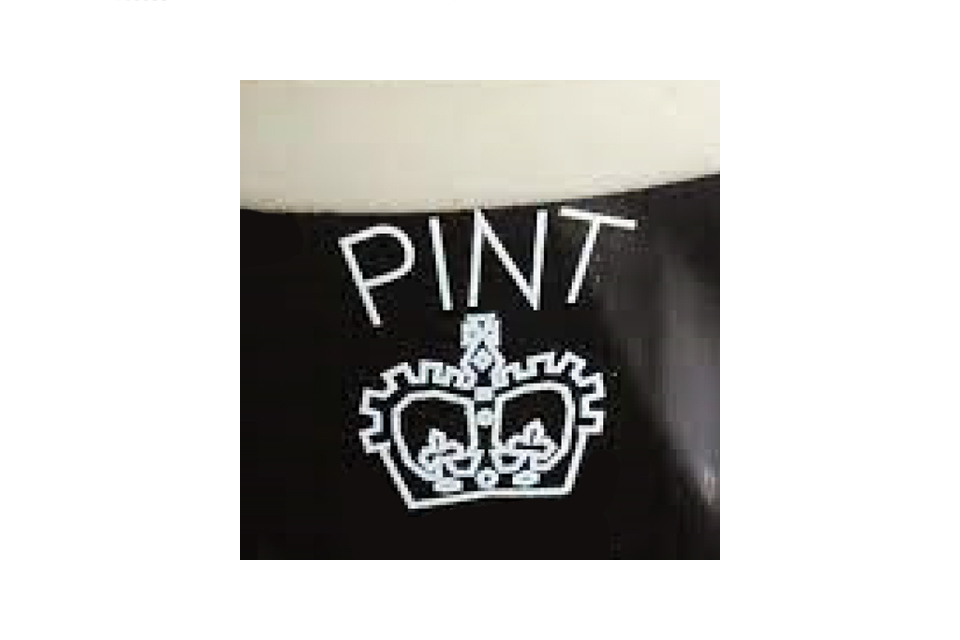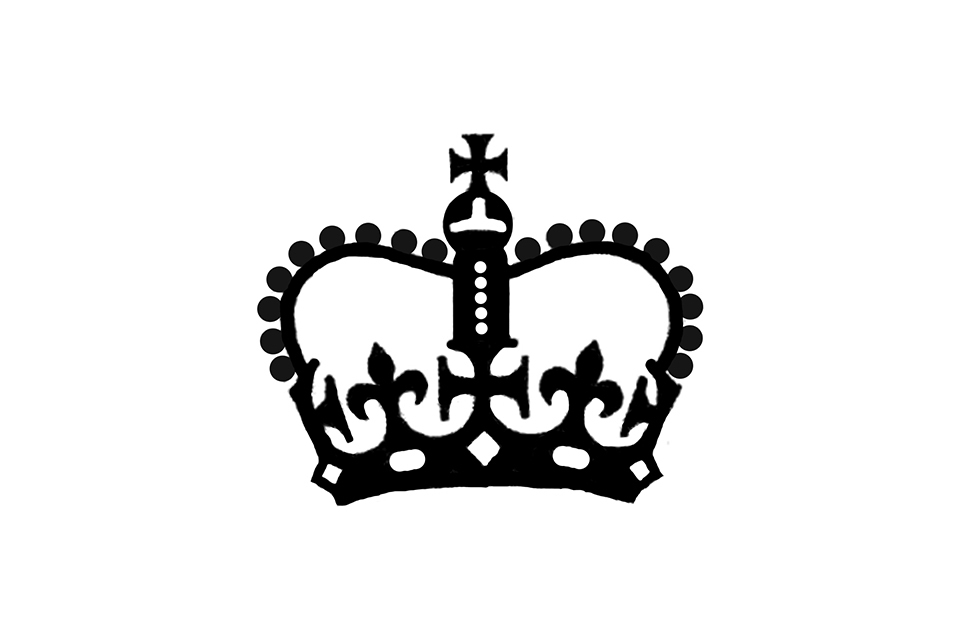Applying a crown symbol to pint glasses
Guidance for businesses.
Introduction
1) For centuries British pint glasses intended for measuring and serving beer were marked with a crown stamp as a declaration that the glass accurately measured a pint. In 2006 the crown stamp was replaced by the CE mark, which was a new conformity marking required by EU legislation, and the crown stamp was no longer required as a conformity marking for pint glasses in the UK.
2) The crown symbol is fondly remembered by many people as a symbol that they associate with traditional pint measures. In recognition of the heritage of the crown stamp, the Government is providing this guidance on how manufacturers can apply a crown symbol to beer glasses as a decorative mark on a voluntary basis.
3) Pint glasses used to measure and sell drinks will still be required to continue to display the legally required conformity markings to show they are accurate, in addition to any voluntary decorative markings.
History of the crown stamp on pint glasses
4) As long ago as 1698 British pint glasses intended for measuring and serving beer were marked with a crown stamp as a declaration that the glass, when filled to the brim or to a line measure, accurately measured a pint of beer. The crown stamp therefore gave customers confidence that they were not being sold a short measure of beer.
5) Before 2006 the crown stamp was used by Local Authority Trading Standards Officers and Government-approved verifiers to indicate conformity with legal requirements. It took the form of an image of the St Edward’s Crown with the identification number of the trading standards inspector or government-approved verifier underneath:

Example of the Crown Stamp on a pint glass in use pre-2006.
Figure 1: An example of the Crown Stamp on a pint glass in use pre-2006.
6) The 2004 EU Measuring Instruments Directive, which came into force in 2006, required the use of the EU-wide ‘CE-mark’ as a conformity assessment marking for pint glasses, alongside the “M” metrology marking. To implement the Directive, legislation was introduced in the UK to replace the crown stamp with the new conformity markings set out by the EU legislation. The new conformity markings were applied by the manufacturer as a declaration that the glass met the legal requirements that applied to it, including for measurement accuracy. As a result, the use of the crown stamp as an indication of measurement accuracy for pint glasses ceased in 2006.
The required conformity markings for pint glasses
7) Today, when glasses are used to measure and sell liquid – such as pint glasses or half pint glasses in a pub – they are classified as ‘capacity serving measures’ and are regulated by the Measuring Instruments Regulations 2016. They are required to measure liquid accurately and must carry the relevant conformity markings to signify that they meet the legal requirements:
- In Great Britain, since 1 January 2021, capacity serving measures are required by the Measuring Instrument Regulations 2016 (as amended) to carry the UKCA marking to indicate conformity with the legal requirements, along with the M marking. CE-marked pint glasses will continue to be accepted on the GB market until 1 January 2025.
- In Northern Ireland, capacity serving measures need to comply with the Measuring Instruments Regulations 2016 as they apply in Northern Ireland under the Northern Ireland Protocol. In order to demonstrate conformity with the requirements, they must carry the CE mark (or CE + UKNI mark if conformity assessment was carried out by a UK approved body), along with the M marking.
Read more about placing goods on the Northern Ireland market
8) The conformity assessment procedure options for capacity serving measures are set out in Schedule 1B to the Measuring Instruments Regulations 2016.
Advice on applying the crown symbol to pint glasses

An example of a crown symbol, the St. Edward’s Crown.
Figure 2: An example of a crown symbol, the St. Edward’s Crown.
9) In addition to the legally required conformity assessment markings set out above, manufacturers can apply other markings to capacity serving measures provided that they:
a) Are not likely to mislead any other person as to the meaning of the marking.
b) Do not impair the visibility, legibility and meaning of the required conformity assessment markings.
10) The crown symbol can be applied on a voluntary basis as a decorative mark in Great Britain and Northern Ireland. Businesses supplying glasses to international markets should continue to ensure that they satisfy the legal requirements of those markets.
11) In line with the requirements above, the application of the crown symbol is limited to use as a decorative mark only and no meaning as to measurement accuracy should be inferred from its presence on a capacity serving measure or other glassware. Only the legally required conformity assessment markings – the UKCA mark in GB (or the CE mark in GB until 1 January 2025) and the CE mark or CE + UKNI mark in Northern Ireland – indicate that a pint glass or other capacity serving measure may be used as a measuring instrument for trade and give confidence that the measure has been assessed and declared by the manufacturer to be in conformity with the regulations. The crown symbol does not indicate compliance with any legal requirements. It is a decorative mark which recalls British history and traditions.
12) Where a crown symbol is applied to a capacity serving measure used for the sale of intoxicating liquor:
a) The crown symbol may be any size and may be placed anywhere on the glass, provided it does not affect the visibility, legibility or meaning of:
- the UKCA marking, CE marking, or UKNI marking
- the M Marking
- the Approved Body or Notified Body number
- the capacity
- any filling mark(s)
b) The crown symbol should not be accompanied by numbers immediately below the crown.
13) Where a decorative crown symbol is applied to a glass that is not a legal capacity serving measure, any person using the glass as a container for liquid they are selling by quantity should ensure that:
a) Any indication of measurement associated with the crown symbol, (e.g. “1 pint”) is not a misleading statement.
b) A legal measuring instrument (e.g. a capacity serving measure or meter) is used for the purpose of measuring for trade in any regulated intoxicating liquor (for example the sale of draught beer or cider).
14) If the glass is not intended for use in trade (for example, if it’s for use in the home), the glass can display any legal and non-copyrighted design, including a crown symbol, in whichever way the manufacturer sees fit.
Updates to this page
-
Guidance updated to reflect the extension of the transition period for UKCA marking.
-
First published.